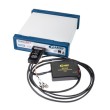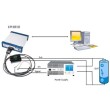A typical system consists of an Interface 1010E potentiostat and an LPI1010 working in conjunction with a Bipolar Power Supply or Electronic Load. A schematic of the system is shown below for impedance measurements on a battery. A similar arrangement can be used to measure a fuel cell.

The LPI1010 with a Power Supply measures the impedance of the Battery. The measurement of I and E at a given frequency allows the calculation of the impedance.
Older Interface 1010Es will require an upgrade at the factory before they can operate an LPI1010.
Customers using their own loads or power supplies may require a custom configuration file and calibration cells. Contact Gamry or your local distributor for further details on these systems and situations.
The Gamry LPI1010 is designed to accommodate the low impedance of batteries and fuel cells. It can measure complex impedance over a frequency range of 10 μHz to 100 kHz (the upper limit is determined by the electronic load or power supply).

Galvanostatic EIS on a 60.9V battery. 10kHz to 1 mHz. 0.5 A rms.
The accuracy of an EIS measurement at high frequencies is dependent upon the bandwidth of the instrument. EIS measurements are usually made at a maximum frequency of 10 kHz. The LPI1010 has a bandwidth of 100 kHz. The critical specification is the bandwidth of the Electronic Load. The Load bandwidth will determine the upper frequency of the EIS measurement. Contact Gamry regarding the bandwidth of your Load.
The precision of a dynamic electrochemical measurement such as EIS is an important issue. The Gamry LPI1010 performs a statistical analysis of the data at each frequency during acquisition. The data is accepted only after the precision criteria are met. The precision criteria can be adjusted by the user.

A Nyquist Plot of a Single PEM Fuel Cell. This data is plotted in the Echem Analyst.
Note the negative impedances at low frequencies.
A fuel cell is a dynamic sample and it can be important to make the measurement quickly. The LPI1010 user has a choice of optimizing Speed or Accuracy during acquisition. When Speed is selected, the precision criteria are relaxed and a minimum amount of information is displayed during the experiment. The measurement time for an EIS measurement in High Speed mode is over three times faster than in High Accuracy mode.
When used to study fuel cells, EIS is always measured in the presence of a significant DC current. The LPI1010 High Voltage Impedance Test System offsets these DC levels to zero so that the AC values can be measured at a high gain for maximum accuracy.
LPI1010 Load/Power Supply Interface 10V Part #992-00192
LPI1010 Load/Power Supply Interface 100V Part #992-00193
LPI1010 Load/Power Supply Interface 100V NF Part #992-00195
LPI1010 Load/Power Supply Interface 1000V Part #992-00194







